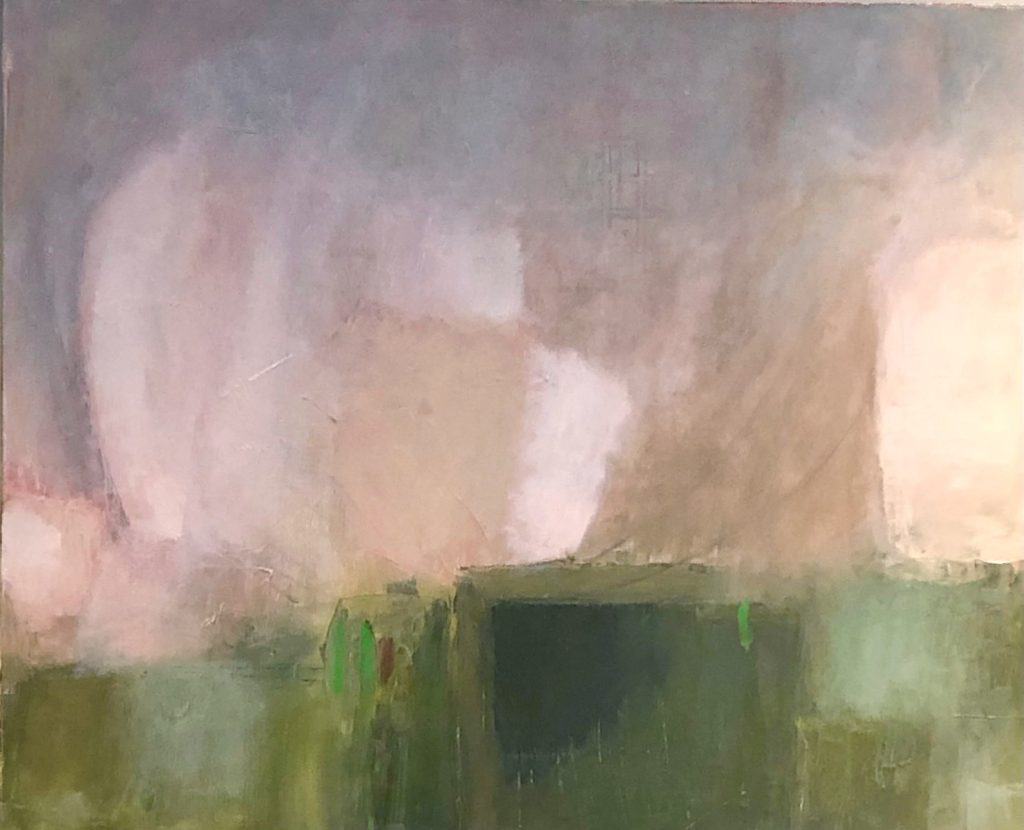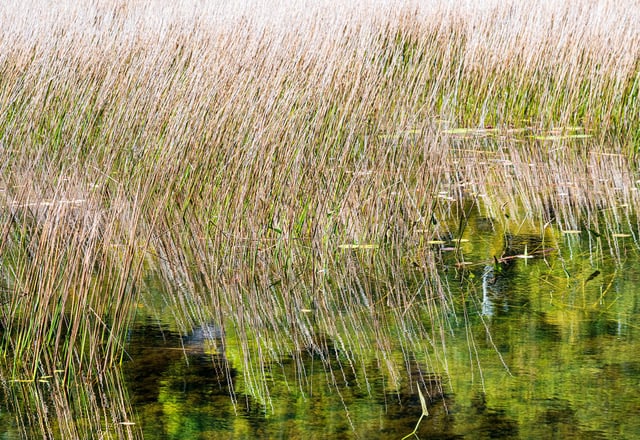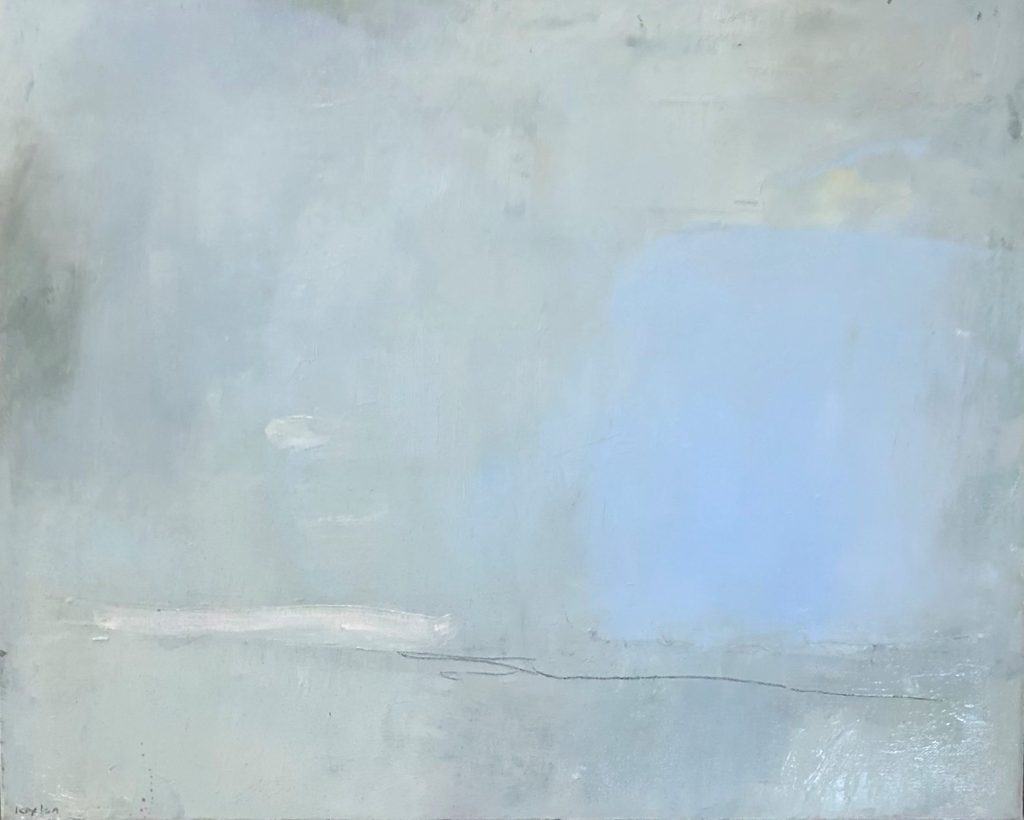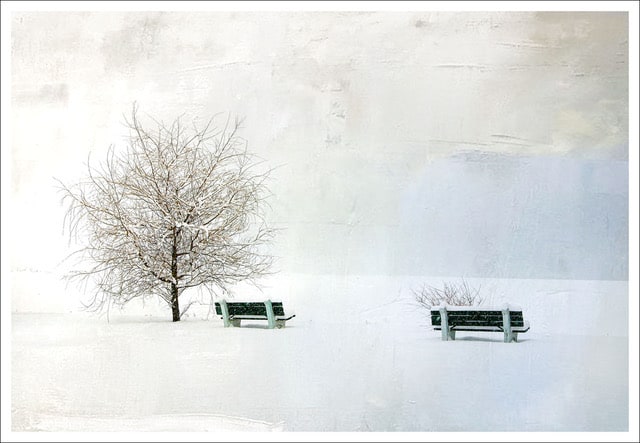

The signs of spring in Ithaca are popping up on every corner. Crocuses have defiantly pushed their way up through the earth, bulky jackets have been shed, and the Farmer’s Market is open at Steamboat Landing once again. In the window of the State of the Art Gallery, a pairing of bright sunflowers invites eager viewers inside. These flowers, one painted, the other photographed, set the tone for an equally warm and renewing show. “Double Vision”, by Ileen Kaplan and David Watkins, is a triumphant collaboration, four years in the making.
For both Ileen and David, art was something they stumbled upon later in life. The moment Ileen decided to take up painting was during a trip to Bavaria with her husband in 1998. It was sunrise, and they were strolling through a beautiful field when she heard a voice say to her “you can paint this.” Never having any mystical or spiritual experience this tangible before, Ileen was shocked and excited. She shared this with her husband, an artist himself, and for Christmas that year he bought her paints. Before this divine intervention of sorts, she had never really thought about painting.
David, on the other hand, was surrounded by art for so long that it was only a matter of time before he built his own practice. He majored in graphic design in college, spent years designing magazines and books, then eventually worked at Cornell University as the graphic artist in their television center. In his various roles at the university over the years, he worked with many artists, writers, and designers and along the way picked up a camera to use for documentation purposes. He was the butt of the typical joke that if he went on vacation with his camera, he had to come home and look at the pictures he’d taken to find out where he’d been. It wasn’t until he received a digital camera and printer as a retirement gift that he began using the camera as an artistic tool, not just a recording device.
Over time, in their respective mediums, both artists became members of the gallery. David remembers himself and his wife being immediately captivated by Ileen’s work when she was applying to join. Both were influenced by each other’s art over the years, admiring each other’s unique use of light and color.
They began kicking around the idea of curating a two-person show around four years ago. Due to the nature of the gallery’s calendar, coordinating a month where they would both be eligible to hang an exhibit together proved to be a bit of a challenge. But through careful planning, they were able to make the dates finally align, and could begin preparing.
Ileen and David approached this exhibit through a unique partnership. Ileen was heavily influenced by a show in the Baltimore Museum of Art where a curator had paired Richard Diebenkorn and Henri Matisses’ paintings together to illustrate how the latter’s work had inspired the former’s. Ileen thought the pairing was fantastic. She would often see David’s work hanging in SOAG and think “I could do a great painting off of that!”. She pitched the idea of creating a show inspired by one another’s work to David, and he was sold. He has always loved when the gallery curated exhibitions based on a theme, welcoming the challenge of working within new boundaries. This felt like an extension of that concept, and he was eager to get started.
Finding a common theme for the exhibition wasn’t a challenge for these creators, as both are already inclined toward nature. David primarily shoots botanicals and landscapes and refers to himself as a “lazy photographer” due to how readily accessible his subject is – the garden right outside his house. Ileen confirms that his perennial garden is unbelievable, and the floral arrangements he grows to photograph are a testament to his green thumb. Ileen’s work is similarly nature-oriented, focused keenly on how light affects subjects, and utilizing a color palette that David boasts is “second to none in the gallery”. As easy as it was to find their topic, the challenge arose when they began contemplating how to create the show itself.
Painting based on a photograph is one thing, as many painters are known to create works by looking at reference images for direct inspiration. Ileen was captivated by the vibrant colors of many of David’s pictures and found ways to incorporate them into her palette while abstracting his subject matter. Capturing a photograph based on a painting, however, requires an entirely different skillset, and a touch of serendipitous luck. David approached this endeavor in two different ways. First, he would use one of Ileen’s paintings as a jumping-off point. Then, he scoured his more than 45,000 digital images to find pictures that matched up with the painting. The second, bigger challenge, was referencing a painting and setting out to take a photograph that pairs well with it. To do this, he began by breaking down the painting into elements. What is the lighting doing? What about the lines? The patterns? Is there something he could find in nature that could work with that? He didn’t strive for mimicry but instead sought out compatible pairings.
One such image was presented to him in the early morning as he stood by Eagle Lake in Maine. Having been working on the show for quite a few months now, he could easily call Ileen’s paintings to mind and often found himself searching for her colors in nature. The way the sun reflected on the pond reeds that morning lit them in a dreamy pink hue, and he was delighted by how similar the coloring was to her painting “Pink Sky”. He captured the image “Reeds and Reflections in Shallow Green Water”, which illuminates the beauty that can be discovered through being inspired by another artist’s work.
An additional unexpected creative merging came when David had the idea to use one of Ileen’s paintings, with her permission, as a textured background in Photoshop and merged it with one of his photographs. Her painting “Winter on the Lake”uses a cool palette to highlight the complex beauty of winter’s still grayness. Layered with David’s “Two Green Benches”, an image captured during a blizzard on the shore at Stewart Park, the collaged piece becomes a conversation between stormy solitude and hopeful snowy reflections.
Now that the show is hung and completed, the duo is pleasantly surprised by how well it all came together. In the months leading up to its opening, they had only seen two pieces paired side by side. Ileen wondered how the end result would look, and when they stepped back to admire their work, they realized that their worries had all been for naught. The show they had waited years to create was finally complete.
“Double Vision” is on view at the State of the Art Gallery from now until May 1st.



Excellent write up.
Thank you, Olivia! You sensitively listened to what we had to say, and then created a piece of writing that is exciting, funny, and that opens a door to the creative process. Brava!
Wonderful show. I also saw the Matisse/Diebenkorn exhibit and found it to be both intriguing and inspiring. The Watkins and Kaplan combination works so well.
Thank you, Olivia, for another well-written and informative contribution.
I’ve already spent some time both at the gallery and in the online show pondering the pairings. It’s a fabulous exhibit. Now, after reading more about the artists and the backstory in creating this exhibit, I’m ready to visit the exhibit again. Thank you, Olivia!
Thanks Olivia for helping the opportunity and challenge of this show come alive. Well done.
Thanks, Olivia, Ileen, and David. Just beautiful!
This was a show of which I had caught a few glimpses as it was in development, and I was hugely excited to see it take physical shape. It exceeded my expectations, which were high… I believe it is one of the most inspired -and inspiring -shows that I have seen at our gallery! And Olivia’s essay, as always, tied all this excitement together in a most perceptive account!
Kudos to all of you!